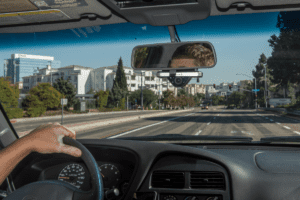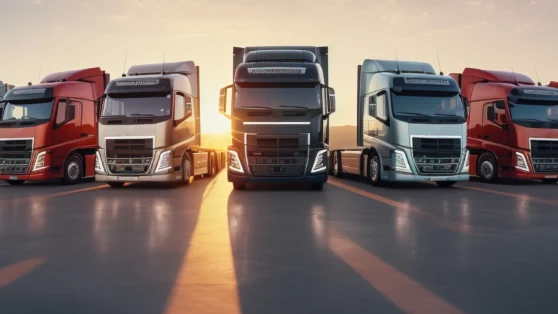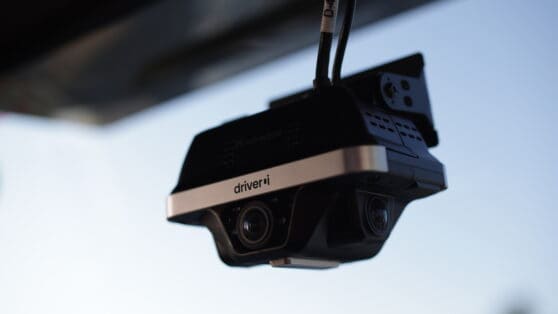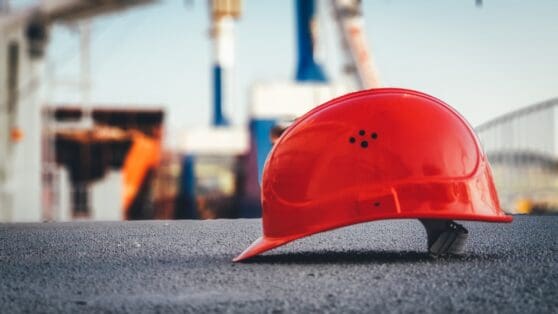What is the Best Dash Cam for Commercial Fleets in 2024?
Picture a scene on a highway: One 18-wheeler drifts into another, causing the truck in the left lane to smash into the median. The event is caught on the left-lane truck’s dash cam, leaving little doubt who’s responsible.
Incidents like this are only one reason that your commercial fleet needs dash cams. Today’s fleet management solutions are sophisticated and robust, using high-quality cameras, AI-enabled analysis, edge computing for real-time feedback, and digital tools to enable accessibility and ease-of-use.
Such dash cam systems are a far cry from early versions, which police were using as early as the 1930s. By 2007, dash cams were in use among 61 percent of local police departments in the U.S. and were starting to gain traction for use in private vehicles, beginning in Russia and rapidly spreading around the world.
Today’s dash cams are small and high-tech, and are used by everyone from individual drivers to large commercial fleets. The global market reached $2.8 billion in 2019, when 36 million dash cams were sold worldwide, according to Grand View Research. Demand is expected to increase steadily for years to come, potentially reaching $7.5 billion by 2027.
Trucking fleets can benefit from advanced dash cams with features like AI-based event detection, GPS, Wi-Fi connectivity, analytics, and other options. An estimated 10 million of these advanced versions were sold in 2019, and this market is likely to grow at 15 percent by 2027.
There are many dash cam options vying for customer attention in this hot market. So what is the best dash cam for commercial fleets? Let’s take a look at the ins and outs of dash cams and what to look for.
What Is a Dash Cam?
A dash cam, short for dashboard camera, is sometimes called a car digital video recorder (car DVR), driving recorder, or event data recorder (EDR). Dash cams are small cameras that are installed with a dash cam mirror mount, typically in the front windshield (near the rearview mirror) and/or the back or other windows.
The term “dash cam” doesn’t do justice to the sophisticated systems that commercial fleets have at their disposal these days. These AI-enabled fleet camera systems use artificial intelligence, machine learning, and other advanced technologies to go far beyond simply recording. These fleet management solutions can provide a 360-degree view, give real-time feedback to drivers, and track and report good driver decision-making.
How Dash Cams Work
Dash cams come in various types, from the very basic to the full-surround, technologically advanced solution. They typically work either by continuously recording or being set to begin recording when triggered by incidents like hard braking and accelerating.
Basic Dash Cams
Basic dash cams are mounted in the front windshield and record the road ahead of the vehicle. They record continuously on a removable SD card, replacing the previous footage upon reaching the memory limit. This option has the advantage of being a simple “set it and forget it” set-up, which makes them popular on the consumer market. They may be hard-wired into the vehicle’s electrical system or plug into a 12V socket or cigarette lighter.
Advanced Dash Cams
Dash cams wirelessly send footage to the Cloud, where it can be stored indefinitely, analyzed by computer software, and retrieved by a third-party if needed. They incorporate a wide variety of features, such as audio recording, GPS logging, speed sensors, accelerometers, and uninterruptible power supplies.
Recording is triggered by various unsafe events or behaviors detected by the AI algorithms or other sensors. Some advanced dash cam systems useful for commercial fleets record continuously in order to capture more subtle instances of dangerous driving, such as distracted driving and aggressive driving like rolling through stop signs, weaving in traffic, and tailgating.
Interior/Exterior and 360 degree Dash Cams
Many of the advanced dash cam systems include multiple cameras to provide a full view of the vehicle. Front, rear, and side dash cams can enable full-surround visibility, and allow for monitoring of loading and unloading as well as driving. Drivers are able to monitor all views on a dashboard in the cab.
Some systems also incorporate an interior view, allowing video recording of the driver. While parents might use this in a car to keep an eye on their teenager’s behavior, this option is particularly useful for trucking companies. The in-cabin cameras can record the driver’s actions to allow oversight of driving behavior and add more useful information about any incidents that arise.
How Netradyne Driver•i Works
Netradyne’s Driver•i system records continuously in HD, capturing and analyzing 100 percent of driving time. Using edge computing, the system analyzes the dash cam footage within the device in real-time, allowing for immediate alerts regarding problems and feedback on the driver’s performance.
Driver•i identifies every stop sign, traffic signal, and road sign, and analyzes the compliance exhibited by the driver. The system can assess speed, following distance, aggressive drivers, and distracted driving, and can identify when a driver is making responsible and proactive driving decisions.
The system’s GreenZone Score is the industry’s first driver score built on positive driving, versus solely focusing on negative events. It shows a real-time assessment of the driver’s performance, and provides in-cabin audio alerts about violations or problems. The system can notify management immediately through the Driveri app or dashboard when a driver commits a violation that needs to be addressed.
A Netradyne dash cam gives drivers access not only to in-cab audio alerts but also to data about their driving via the Driver•i mobile app. Automating this info-sharing reduces the need for management to step in and request changes—drivers can monitor their GreenZone score themselves and make adjustments to ensure the score stays high.
Driver•i systems fall in three categories: road-facing camera only (D-211), road-facing and cabin-facing cameras (D-210, D-215), and four cameras that provide 360-degree views (D-430, D-450). All systems record continuously and analyze thousands of data points directly on the Driver•i device.

Creating a 360-degree Dash Cam
The average dash cam provides a view out the front of the vehicle, and some standard systems provide 270-degree visibility. Netradyne’s Driver•i Hub fleet safety solution adds onto its base systems to provide additional visibility around the vehicle. Designed for expandability, Driver•i Hub supports up to four additional cameras for additional views.
With WIFI connectivity to the Driver•i device, Driver•i Hub uses the same high-quality HD video for added visibility, while also adding support for an in-cab monitor designed for the driver to provide a complete view of all camera angles.
How To Install a Dash Cam
Dash cam installation is straightforward. Commercial fleet drivers will mount the device close to the centerline of the windshield, within the wipe swipe zone, and then run the cable down through the dashboard to the diagnostic port in the engine. That port type depends on the engine type, and thus the type of cable plug required will depend on the details of the vehicle. The most common plug types are 6-pin, 9-pin, and OBDII. After the dash cam is plugged in, it draws power and vehicle data.
Netradyne Driver•i dash cam installation can be easily completed with the help of an Installer app that enables system verification, pairing Driver•i to the vehicle, and streaming live camera views. Once the driver has used the app to begin streaming dash cam videos, they’ll be able to adjust the camera to ensure that the dash cam mount is positioned to allow for outward views that minimize the vehicle hood.
The Benefits of a Dash Cam
Dash cams provide a slew of benefits to commercial fleets, as well as to individual drivers. While drivers have generally been slow to warm up to dash cams, with the new generation of high-touch technology, they are beginning to understand the benefits to their careers and their safety, leading to a much more accepting attitude and improvements in driver retention for companies that invest in top-of-the-line systems.
#1 Preventing Distracted Driving and Aggressive Driving
One major benefit of dash cams, especially AI vehicle camera systems with real-time alerts like Netradyne Driveri, is the reduction of distracted driving and aggressive driving. Drivers who engage in poor decision-making behind the wheel can be notified of mistakes in real-time and can review footage to learn how to do better in the future.
#2 Increasing Safety Compliance
What is safety compliance? It’s just what it sounds like: the process of getting and staying in line with safety laws and regulations.
The Federal Motor Carrier Safety Administration (FMCSA) uses its Compliance, Safety, Accountability (CSA) scores to assess the risk motor carriers pose to roadways. Roadside inspections, crash reports, investigation results, and registration details all contribute to these scores. Dash cams can help keep a carrier’s score in a good range by ensuring that defensive driving techniques are continually reinforced by technological feedback.
#3 Providing Dash Cam Exoneration Videos
Emphasizing the way that dash cams can provide exoneration for truck drivers in the case of an accident is a strong way to promote driver buy-in for their use. Considering that the American Trucking Association reports that 80 percent of car-truck fatal crashes are caused by car drivers, it’s essential for commercial fleets to be able to provide evidence of what happened in any given instance. Exoneration footage of crashes provide for some crazy dash cam footage that often showcase examples of aggressive driving on the part of car drivers.
What Makes Netradyne’s Dash Cam Different?
If you’re asking, “what is the best dash cam on the market?” instead, think about instead asking, “what is the best dash cam on the market for my needs?”
The answer will depend on your fleet size and purpose, as well as how extensive a view you need; how much you value real-time feedback, continuous streaming, and video quality; whether you want your drivers’ good driving behavior identified; and other concerns.
Netradyne Offers High-quality, Continuous Video to Large Fleets
Netradyne is also different from legacy systems in that it records and analyzes driving 100 percent of the time, instead of being triggered by events like hard braking or acceleration. This means that far more of the drivers’ actions (and inactions) can be stored and analyzed. Netradyne’s high-resolution cameras allow for not only real-time analysis that takes street signs and other elements into account but also the production of very clear footage that can be used in court.
Netradyne Assists in Driver Retention
Netradyne Driver•i is a great answer to the riddle of how to develop driver buy-in for the use of dash cams. This is the only fleet management solution on the market that recognizes and incentivizes positive driving behavior, which helps empower drivers and leads to greater driver retention.
Drivers get a GreenZone Score that is based not only on risky driving behavior but also on the use of defensive driving techniques that increase safety and prevent accidents. The feedback that the system offers amounts to continuous truck driver coaching that can increase good driving behavior.
DriverStar, an extended feature to GreenZone, uses AI-enhanced capabilities to provide a much deeper view into positive driving behavior, analyzing data and alerting safety managers when a driver reacts safely to a challenging situation. This feature provides drivers the opportunity to improve their GreenZone score based on these events and allows safety managers to recognize and reward extraordinary driving behaviors exhibited by their truck drivers.
Dash Cam Features Are Flexible and Easy To Use
Netradyne is also different from competitors in the flexibility and quality of its system and cameras. The two base options — D-210 and D-410 — provide either two or four viewpoints via extremely high-quality video that can clearly read road signs and license plates. The DriveriHub can be added on to make the system into a 360-degree dash cam that the driver can monitor easily from inside the cab.
In addition to all these benefits, Netradyne is simple to install. The dash cam mount attaches easily and the Installer app assists in making sure the viewpoints are optimized and the streaming is working properly.
Don’t Go Without a Dash Cam
Dash cams can’t prevent every accident but they sure can help. The one we imagined at the beginning of this article may still have happened even if the passing truck had Netradyne’s most advanced system on board. But the likelihood might have been slashed.
These systems not only help drivers be defensive in real-time, they also serve as a digital training method for increasing good driver behavior and increasing safety, to the benefit of fleets, truckers, and other drivers.
Check out Netradyne’s Driver Training Tips to see how these technology solutions fit into the project of setting drivers up for safety on the road.
FAQ
- What are the benefits of cloud connectivity in advanced dash cams?
Cloud connectivity in advanced dash cams offers numerous benefits for fleet managers. One major advantage is the ability to access real-time video streaming and perform data analysis through a robust cloud platform. This empowers fleet managers with instant access to any camera within the fleet, enhancing their ability to respond promptly in the event of an incident. Moreover, the seamless integration of dash cams with fleet management systems ensures efficient and streamlined operations. The utilization of cloud connectivity not only enables quicker response times but also facilitates the integration of video footage with other relevant fleet data, enabling managers to make more informed decisions regarding safety, performance, and overall fleet optimization. - What are the essential features of semi-truck dash cameras to consider?
When considering the essential features of semi-truck dash cameras, there are several factors to keep in mind. One important trend to consider is the integration of artificial intelligence (AI) and machine learning. Dash cameras equipped with these technologies can analyze real-time footage to detect risky behaviors like drowsy driving, distraction, or traffic signal violations. This capability can greatly enhance safety on the road.Cloud connectivity is another crucial feature to consider. Advanced dash cams with robust cloud connectivity enable real-time video streaming and data analysis. This means fleet managers can have instant access to any camera in the fleet, quicker response times in the event of an incident, and seamless integration with fleet management systems. This feature enhances efficiency and allows for better incident management.Integration with Advanced Driver Assistance Systems (ADAS) is another essential feature. Dash cameras of the future are starting to integrate ADAS-related features such as collision warning systems, lane departure warnings, and forward-collision warnings. These features provide real-time alerts to drivers, helping to prevent accidents before they occur. When investing in a dash camera, it is important to consider its compatibility and integration with ADAS technologies for enhanced safety.Furthermore, the integration of Driver Monitoring Systems (DMS) is becoming increasingly important. Dash cameras that can integrate with DMS offer more robust monitoring capabilities, including the detection of driver fatigue and distraction. By utilizing real-time, AI-driven analytics, this integration revolutionizes the trucking industry by optimizing road safety and operational efficiency. - Why is it important to take action for safety and invest in dash cams?
Taking action for safety and investing in dash cams is of utmost importance for truckers and fleet managers. These devices play a crucial role in creating a safer driving environment and can bring about significant cost savings for your company by reducing accidents and insurance claims.As a truck driver or fleet manager, your responsibility is not limited to getting goods from point A to point B; it also includes ensuring the safety of your drivers and protecting your assets. Dash cams act as witnesses on the road, capturing everything that unfolds in front of you. By having a dash cam installed, you not only enhance the safety of your drivers but also equip yourself with concrete evidence in case of any incidents or disputes.Moreover, dash cams promote safer driving habits among truck drivers. The knowledge that their actions are being recorded encourages them to be more cautious, follow traffic regulations diligently, and refrain from engaging in risky behaviors. By instilling a culture of safe driving, you can significantly reduce the chances of accidents and safeguard your drivers, the cargo, and other road users.






